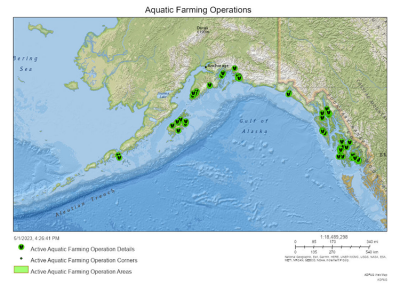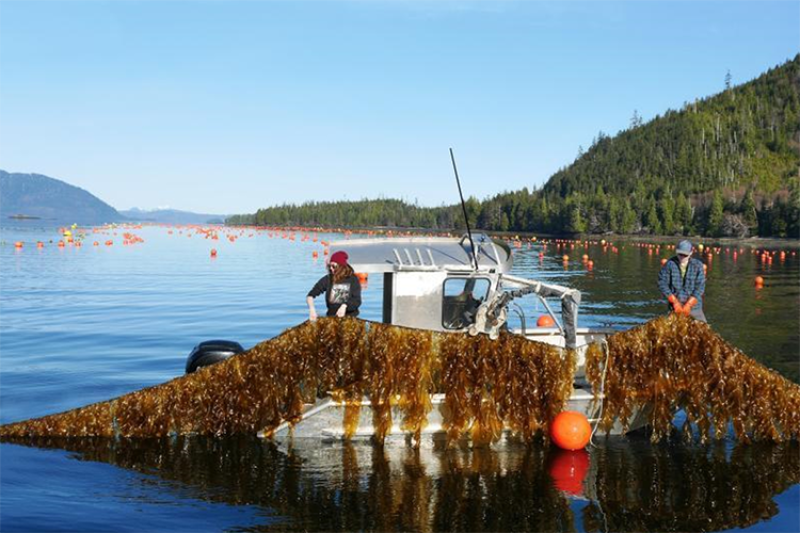NOAA Fisheries has chosen Alaska as the next region in which to look for Aquaculture Opportunity Areas, following on planning already underway off the southern California coast and in the Gulf of Mexico.
An Aquaculture Opportunity Area is a defined geographic area that NOAA has determined to be environmentally, socially, and economically appropriate to support multiple commercial aquaculture operations. NOAA also evaluates these areas through both spatial analysis and the National Environmental Policy Act process. Sustainable marine aquaculture – also referred to in Alaska as mariculture – currently helps support Alaska’s blue economy, contributing to sustainable seafood, and local economies.
The effort to identify Aquaculture Opportunity Areas will be focused in Alaska state waters based on feedback from stakeholders, tribes, and current industry interest. NOAA will only consider shellfish and seaweed farming; finfish farming in Alaska state waters is prohibited by law. With more coastline than all of the Lower 48 states combined, Alaska is uniquely positioned to benefit from growing the marine aquaculture industry.
“Selecting Alaska to begin the process of identifying Aquaculture Opportunity Areas supports long-term goals for both NOAA and the State of Alaska, and strengthens our federal and state partnership,” said NOAA Fisheries Alaska Regional Administrator Jon Kurland. “We look forward to working with our state partners to increase seafood production from aquaculture, which has potential for significant growth into the future.”
NOAA Fisheries held a 60-day public comment period, which included hosting five listening sessions, in late 2020. Alaska received more letters of support than any other region. Individuals, industry, research institutions, Alaska Native Organizations, and the Speaker of the House of the Alaska Legislature submitted public comments in support of AOAs. We also received comments in support of future AOAs for shellfish and seaweed in Alaska from the Alaska Department of Fish and Game and Alaska Governor Dunleavy. NOAA received no comments in opposition to considering AOAs in state waters.
The Alutiiq Pride Marine Institute is a tribally managed marine research facility located in Seward, Alaska, and serves as a major subsidiary of the Chugach Regional Resources Commission, a tribal consortium for the native peoples of Southcentral Alaska that submitted a letter of support for AOA identification in Alaska.
"Economic Development and managing local shellfish populations through mariculture has been a priority for the Chugach Regional Resources Commission's Alutiiq Pride Marine Institute for over three decades. We look forward to sharing our experience with the AOA process," said Executive Director Willow Hetrick-Price.
“The timing of NOAA’s decision to select Alaska is perfect,” said Julie Decker, previous chair of the Alaska Mariculture Task Force. “A large coalition of partners in Alaska recently received a $49 million Build Back Better grant from the Economic Development Administration to support growth of mariculture. NOAA’s work to consider AOAs will complement and build upon this investment. These are exciting times in Alaska!”

Alaska currently has 92 active aquatic farm and hatchery operation permits, including the largest kelp farm in the United States. The state’s aquatic farms grow shellfish, seaweed, sea cucumbers, and urchins, and are located along the coastline in Southeast, Southcentral, and Southwest Alaska.
In recent years, Alaska has seen a significant increase in aquatic farm applications and desired acreage. The amount of permitted acreage increased from less than 350 in 2016 to nearly 1,300 in 2022, or an approximate 271 percent increase in 6 years. In 2022, aquaculture production sales in Alaska totaled $1.9 million. But there is still room to grow.
The Alaska Mariculture Development Plan identified the goal to grow a $100 million mariculture industry in 20 years. The Alaska Mariculture Alliance, with 130 members across the state, was established to promote and support a robust and sustainable mariculture industry for Alaska. It is the successor organization to the Alaska Mariculture Task Force and has adopted the Alaska Mariculture Development Plan as a guiding document. NOAA Fisheries has served on both groups.
“We are excited that Alaska has been selected for AOA identification,” said AMA Executive Director Jason Lessard. “The value that aquaculture will provide to our coastal communities through economic opportunity and food security cannot be overstated. The work NOAA will provide during this process will be a tremendous resource for Alaska as we continue to develop this industry in a responsible, forward-thinking manner.”
Alaska recently received nearly $100 million in funding to support the growth of the aquaculture industry through the Build Back Better Mariculture Cluster Project, Exxon Valdez Oil Spill Trustee Council, and other state and federal contributions. Through the AOA identification process, NOAA will actively engage with the aquaculture stakeholder community. We will provide needed spatial analysis, environmental review, and leverage other investments being made in Alaska.
NOAA has a variety of proven science-based tools and strategies that can be used to consider how and where to sustainably develop aquaculture. Aquaculture farms can complement wild-capture fisheries, provide ecosystem services, and be compatible with other human uses of the oceans and minimize environmental impacts. They will also boost development of our nation’s seafood processing and distribution infrastructure.
NOAA Fisheries’ research activities for Alaska aquaculture have included oysters, seaweed, sea cucumbers, pinto abalone, weathervane scallops, and blue and red king crab. NOAA’s Ted Stevens Marine Research Institute in Juneau and the NOAA Kodiak Lab in Kodiak provide good research bases to support AOA identification in Alaska. Both sites have staff, small vessels, and analytical lab space available for aquaculture-related research, as well as ongoing research partnerships with seaweed and shellfish growers in each region.
Identifying AOAs is an opportunity for proactive stewardship to use best available science-based guidance on sustainable aquaculture management. Aquaculture in AOAs will support environmental, economic, and social sustainability. This approach has been refined and used widely within states and by other countries with robust, sustainable aquaculture sectors.
Marine aquaculture is part of the NOAA Fisheries’ strategy for economic and environmental resilience in coastal communities and supporting healthy oceans. Aquaculture is resistant to many effects of climate change, and offers mitigation and adaptation benefits.
The size and location for AOAs will be investigated through spatial analysis, Indigenous Knowledge, and public engagement. This will allow NOAA and the State of Alaska to identify areas that are appropriate for commercial aquaculture. NOAA’s National Centers for Coastal Ocean Science will provide spatial planning support for Alaska AOA planning. Spatial planning will utilize whole-ecosystem spatial modeling methods aimed at capturing best available data and stakeholder input. While identifying AOAs can help applicants with site selection and environmental analysis, it is not a preapproval for any location. Applicants will still have to go through the full state and federal permitting processes.
NOAA chose the federal waters off southern California and in the Gulf of Mexico in 2020 to begin the process of identifying AOAs. We are now moving forward in the state waters of Alaska after considering public, tribal, and stakeholder input and evaluating the resources available. We will continue to identify new geographic areas nationally as resources allow.
The State of Alaska will serve as a crucial partner with NOAA in designing and identifying appropriate locations for AOAs. These areas will be shaped through a public process that provides multiple opportunities for constituents to share their tribal, community, and stewardship goals, as well as critical insights. NOAA Fisheries expects to solicit public comments in Alaska on framing the geographic study areas soon.






